14
7
There's an Internet café that I frequent, and I've noticed that after restarting any computer - no matter what I did on that computer - it goes back to the exact same state as it was before, with all the changes discarded.
I can install programs, uninstall programs, tamper with all kinds of settings, but once the computer restarts - it's exactly like before.
I'm curious what could be the way they achieve this, is it software related or hardware related?

4Can you tell exact OS version? – Jet – 2014-06-20T09:55:46.623
You might enjoy reading about DNA Lounge Kiosks, which solve the same problem.
– RedGrittyBrick – 2014-06-21T11:38:06.947